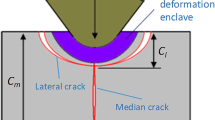Abstract
A micro-grinding approach is proposed to fabricate micro-groove array on tool rake surface. These micro-grooves were used to rapidly dissipate cutting chips and heat from cutting zone for eco-cutting of titanium alloy without any coolant. This tool is called micro-grooved tool. The objective is to replace chemical and high-energy-beam etching approaches because they have not yet been able to control micron-scale groove shape accuracy. In this study, a superhard diamond wheel V-tip was employed to perform a micro-grinding through a traverse grinding. After micro-grinding, these micro-grooves were characterized by the mean depth of 155.1 μm, the mean form error PV of 7.8 μm and the mean tip radius of 45.6 µm. Firstly, traditional plate tool, orthogonal micro-grooved tool and diagonal micro-grooved tool were employed to perform a dry turning of titanium alloy, respectively; then, tool wear, surface roughness, chip topography and shear angle were investigated. It is shown that the sharpened diamond wheel V-tip is valid to grinding micro-groove array on tool rake surface without any burrs. Furthermore, the micro-grooved tools may reduce the cutting sparks, tool wear, 3D chip size and chip saw-tooth size compared to traditional plate tool. The diagonal micro-grooved tool may decrease tool wear by 6.7% and surface roughness by 37.3% and increase shear angle by 24.3% against orthogonal micro-grooved tool, respectively. This is because the diagonal micro-grooving direction is identical to the cutting chip flowing on tool rake surface. It is confirmed that the diagonal micro-grooved tool is applicable to a stable dry cutting of titanium alloy.
Similar content being viewed by others
References
Hirosaki, K., Shintani, K., and Kaneuji, A., “Study on high speed cutting of Bio-titanium alloy — tool wear pattern and mechanism of binder-less PcBN tool —,” Journal of the Japan Society for Precision Engineering, Vol. 72, No, 2, pp. 219–223, 2006.
Sun, S., Brandt, M., and Dargusch, M. S., “Machining Ti-6Al-4V alloy with cryogenic compressed air cooling,” International Journal of Machine Tools and Manufacture, Vol. 50, No. 11, pp. 933–942, 2010.
Machai, C. and Biermann, D., “Machining of β-titanium-alloy Ti-10V-2Fe-3Al under cryogenic conditions: Cooling with carbon dioxide snow,” Journal of Materials Processing Technology, Vol. 211, No. 6, pp. 1175–1183, 2011.
Cantero, J. L., Tardío, M. M., Canteli, J. A., Marcos, M., and Miguélez, M. H., “Dry drilling of alloy Ti-6Al-4V,” International Journal of Machine Tools and Manufacture, Vol. 45, No. 11, pp. 1246–1255, 2005.
Che Haron, C. H., Ginting, A., and Arshad, H., “Performance of alloyed uncoated and CVD-coated carbide tools in dry milling of titanium alloy Ti-6242S,” Journal of Materials Processing Technology, Vol. 185, No. 1–3, pp. 77–82, 2007.
Ginting, A. and Nouari, M., “Surface integrity of dry machined titanium alloys,” International Journal of Machine Tools and Manufacture, Vol. 49, No. 3–4, pp. 325–332, 2009.
Kawasegi, N., Sugimori, H., Morimoto, H., Morita, N., and Hori, I., “Development of cutting tools with microscale and nanoscale textures to improve frictional behavior,” Precision Engineering, Vol. 33, No. 3, pp. 248–254, 2009.
Chang, W., Sun, J., Luo, X., Ritchie, J. M., and Mack, C., “Investigation of microstructured milling tool for deferring tool wear,” Wear, Vol. 271, No. 9–10, pp. 2433–2437, 2011.
Sugihara, T. and Enomoto, T., “Development of a cutting tool with a nano/micro-textured surface—Improvement of antiadhesive effect by considering the texture patterns,” Precision Engineering, Vol. 33, No. 4, pp. 425–429, 2009.
Obikawa, T., Kamio, A., Takaoka, H., and Osada, A., “Microtexture at the coated tool face for high performance cutting,” International Journal of Machine Tools and Manufacture, Vol. 51, No. 12, pp. 966–972, 2011.
Xie, J., Zhuo, Y. W., and Tan, T. W., “Experimental study on fabrication and evaluation of micro pyramid-structured silicon surface using a V-tip of diamond grinding wheel,” Precision Engineering, Vol. 35, No. 1, pp. 173–182, 2011.
Sun, J. and Guo, Y. B., “A new multi-view approach to characterize 3D chip morphology and properties in end milling titanium Ti-6Al-4V,” International Journal of Machine Tools and Manufacture, Vol. 48, No. 12–13, pp. 1486–1494, 2008.
Author information
Authors and Affiliations
Corresponding author
Rights and permissions
About this article
Cite this article
Xie, J., Luo, MJ., He, JL. et al. Micro-grinding of micro-groove array on tool rake surface for dry cutting of titanium alloy. Int. J. Precis. Eng. Manuf. 13, 1845–1852 (2012). https://doi.org/10.1007/s12541-012-0242-9
Received:
Accepted:
Published:
Issue Date:
DOI: https://doi.org/10.1007/s12541-012-0242-9




